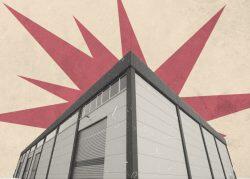The Inland Empire is the epicenter for logistics warehouses in Southern California. And the hub for warehouse growth is the city of Ontario, according to a first-of-its-kind map.
The city east of Los Angeles once blanketed by orange groves is now covered with distribution warehouses, the Riverside Press-Telegram reported, citing a joint study by Pitzer College and Radical Research.
The map was drawn up by environmental consultant Mike McCarthy and Susan Phillips, a professor of environmental analysis at Pitzer’s Robert Redford Conservancy for Southern California Sustainability in Claremont. It ranks IE communities by how heavily they’re inundated with warehouses.
Ontario ranked No. 1, with 650 warehouses containing 222 million square feet, covering 15.9 percent of land, according to the online map. In June, Amazon.com signed a lease for its biggest-ever warehouse, a 4.1-million-square-foot facility in Ontario.
It was followed by Fontana, with 326 warehouses and 122 million square feet; Rialto, with 174 warehouses and 96.1 million square feet; and Chino, with 264 warehouses and 91.8 million square feet.
The March Joint Powers Authority, the public agency tasked with redeveloping former March Air Force Base property, has 45 warehouses, with 36.7 million square feet, covering 19.3 percent of authority land straddling Riverside and Moreno Valley.
“It’s clear to anybody who drives on the roads how widespread the problem is,” Mike McCarthy, owner of Radical Research and an adjunct professor at Pitzer, told the newspaper. “But collectively, they’re all making this decision (to approve more warehouses). And I want to just illustrate where it’s happening the most.”
The Inland Empire, with its abundance of flat, undeveloped land, its nexus of freeways, rail lines and airports, its closeness to the ports of Los Angeles and Long Beach and a largely blue-collar workforce, has long been prime real estate for the logistics industry.
But in the last few years, the number of Inland warehouses has exploded during soaring e-commerce demand boosted by the coronavirus pandemic.
The number of Inland Empire “big box” distribution centers grew 54 percent from 463 in 2009 to 711 in 2020, according to Statista, a market and consumer data firm.
That means more jobs — and cash — in a region bypassed by the tech and healthcare booms. But it also means more truck traffic and diesel trucks spewing air pollution that’s blamed for early deaths, health problems in adults and stunted development in children.
McCarthy is a member of Riverside Neighbors Opposing Warehouses, which he said opposes “industrial zoning (and) warehouses next to residential communities and in general the over-saturation of warehouses in the Inland Empire.”
Others point to the economic benefits of logistics. Paul Granillo, CEO of the Inland Empire Economic Partnership, said the goods movement industry is the region’s largest employer and supports more than 350,000 jobs.
“The Inland Empire came out of the Covid recession faster than Los Angeles (and) faster than Orange County,” Granillo told the Press-Enterprise. “And it’s all due to the fact that the logistics sector became absolutely essential to people’s life and survival during the Covid pandemic.”
The Pitzer map uses information from county assessors’ databases in Los Angeles, Riverside and San Bernardino counties. Geospatial files show the location and size of land parcels and, with the help of the databases’ internal coding, “we identify whether we think each individual parcel is a warehouse in a standardized way,” McCarthy said.
That information is merged with data on city boundaries to show logistics clusters in cities and land overseen by the March Joint Powers Authority. The map doesn’t include warehouses in unincorporated areas, where land-use decisions are made by county boards of supervisors.
According to McCarthy, the joint powers authority has the highest density of warehouses in the Inland Empire.
“We inherited federal lands from the U.S. Air Force with the mission of creating jobs in Riverside County,” Grace Martin, the March authority’s executive director, said in an email.
“Commerce and logistics were envisioned on our lands since 1996, in alignment with the logistics nature of March Air Force Base.”
What stood out to McCarthy was how warehouses were concentrated near March Air Reserve Base and San Bernardino and Ontario international airports. That means the logistics boom is “not serving local customers and local people with e-commerce,” he said.
— Dana Bartholomew
Read more


